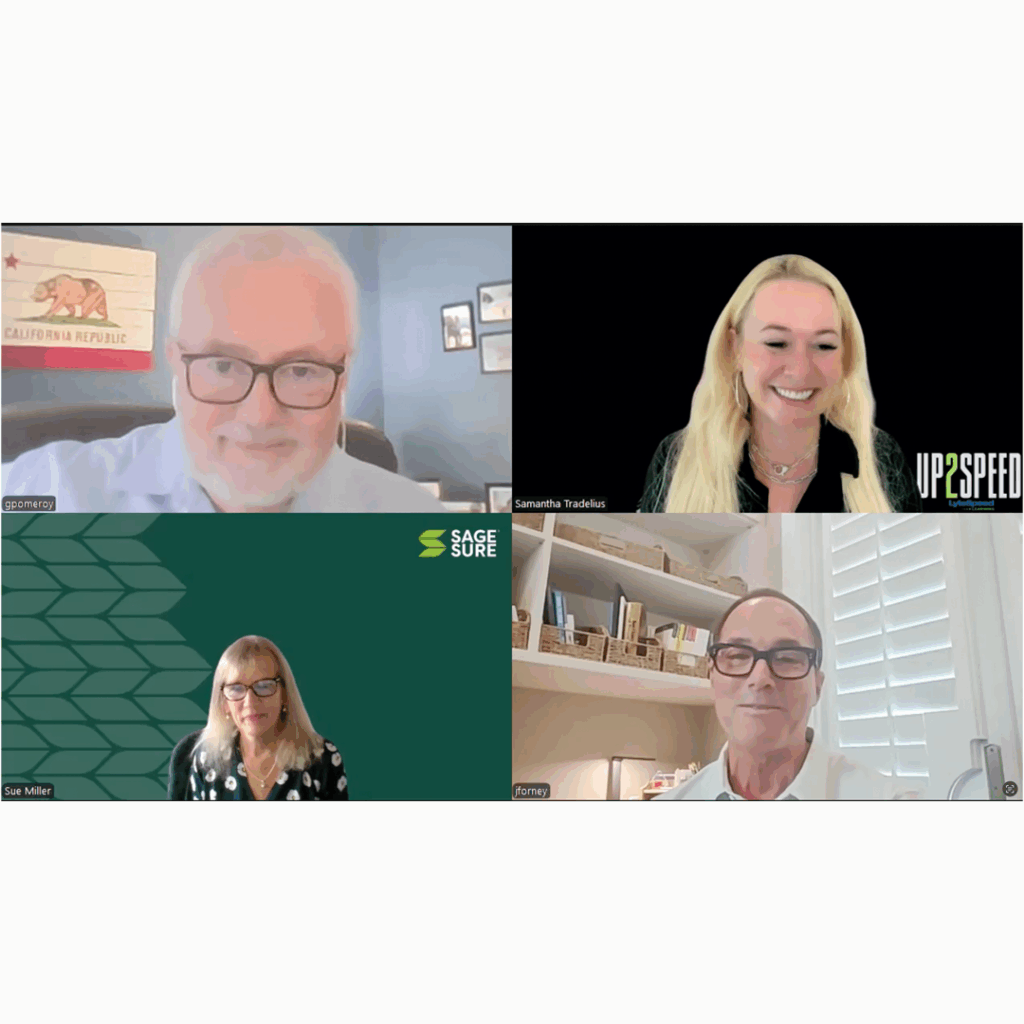
Why 90% of Californians Are Rolling the Dice and What Smart Leaders Are Doing About It
If you live in California, odds are you don’t have earthquake insurance. Nine out of ten homeowners don’t.
Podcast: Up to Speed
“All right, welcome back to Up 2 Speed. We’re talking to some insurance royalty, some icons in the insurance industry.
We’ve got John Forney, the CEO of GeoveraNova. We’ve got Glenn Pomeroy back. He is the Chief Strategy Officer of GeoveraNova.
We are also joined by Sue Miller, who is the head go-to market west representative at SageSure, which is just a really cool company that’s bringing in a lot of really innovative products to the space.” ~ Samantha
Listen to the Podcast: Apple, Podbean, Spotify
It is remarkable when you think about it. The same state that leads the world in innovation, real estate prices, and economic output sits on some of the most active fault lines on the planet. Yet most people have not even had a conversation about what happens after the ground moves.
That’s the disconnect people like John Forney, CEO of GeoVera Nova, are trying to fix. He’s spent over two decades in the property catastrophe business, dealing with hurricanes, earthquakes, and everything in between and he still loves what he does.
“Insurance is a social good,” he says. “It’s part of the economic fabric that makes homeownership possible.”
He’s right. You can’t get a mortgage without insurance. Take that away, and the housing market collapses, along with the jobs, wealth, and stability built on top of it. Insurance does not just rebuild homes it keeps economies from falling apart.
What Happens When There’s No Coverage
John Forney brings up Hurricane Katrina. When it hit New Orleans in 2005, half the city’s population left within a year. Entire neighborhoods disappeared, not because people didn’t care but because they couldn’t afford to rebuild.
Now imagine that same story in California. The world’s fourth-largest economy, gone quite because people can’t rebuild their homes. It’s not far-fetched. Without coverage, recovery depends on federal aid and as Forney points out,
“The federal government doesn’t have the money or political will to bail out California after an earthquake.”
Insurance, in that context, isn’t just a financial product. It’s imported capital, global reinsurance money flowing into local communities when they need it most. That’s not theory. It’s a functioning economic engine.
Earthquakes Are Inevitable, Displacement Doesn’t Have to Be
Glenn Pomeroy, GeoVera Nova’s Chief Strategy Officer and the former CEO of the California Earthquake Authority, explains the risk simply:
“California is earthquake country. The science is settled. These plates are moving it’s not a question of if, it’s when.”
He uses a great analogy: think of the Earth like a hard-boiled egg. The crust, where we live is the thin shell sitting on top of molten movement. That shell cracks. That’s what an earthquake is.
Pomeroy’s point isn’t to scare anyone. It’s to remind us that earthquakes don’t follow calendars or warnings. California averages 20 measurable seismic events every morning before most people even finish their coffee. The odds are constant, but our preparation isn’t.
Insurance That’s “Sold,” Not “Bought”
Here’s where Sue Miller, SageSure’s Head of Go-to-Market West, brings things down to earth.
““People don’t buy earthquake insurance, it has to be sold,” she says.
It is simply the nature of the business. Homeowners rarely wake up thinking about fault lines or deductibles. They’re thinking about their mortgage, their car payment, maybe their next vacation. So, it’s up to agents to start the conversation and make it real.
Half of homeowners, Forney notes, do not even know they do not have earthquake coverage. When the next big one hits, those same people are going to look to their agent, not FEMA for answers.
One of the other big misconceptions? Deductibles.
Most people think a 10% deductible means they have to pay that amount before they see a dime. That’s not how it works. The insurer subtracts that percentage from the payout and you still receive the rest. It’s a crucial detail, and one that changes minds fast once explained clearly.
Why the Market Finally Makes Sense
After the 1994 Northridge quake, insurers nearly abandoned the California market. The damage, $40 billion worth scared everyone. The state responded by creating the California Earthquake Authority, and private companies like GeoVera stepped in with better modeling, smarter pricing, and modern risk management.
Today, the market is stronger than it’s ever been. There’s choice, there’s flexibility, and there’s innovation. What’s missing is awareness.
Fannie Mae and Freddie Mac don’t require earthquake insurance for mortgages which is why most lenders don’t push it. Until that changes, the responsibility sits squarely with agents and brokers to bridge the gap between “optional” and “essential.”
October Is the Perfect Time to Start
Every October, California runs the Great ShakeOut, a statewide drill that teaches people to drop, cover, and hold on. Millions participate from schools and offices, to families. It’s the one day a year when earthquakes are top of mind.
Forney and his team see it as more than a safety exercise, it’s an opening. A reason to start real conversations about financial readiness and community recovery.
Because preparation doesn’t start with duct tape and bottled water. It starts with knowing your risks and choosing not to ignore them.
While the Ground is Still
You don’t need a crystal ball to know another major earthquake will hit California. You just need to decide which side of it you’ll be on: the side rebuilding with help, or the side waiting for help that may never come.
For homeowners, that means first asking your agent the hard question: Do I actually have earthquake coverage?
For agents, it means leading those conversations before the news cycle forces them. And for executives and policymakers, it means fixing the gaps now, while the ground is still. Because when the shaking starts, it’s too late to wish you’d paid attention.
